hibernate01: 소개, 구성, 구성 파일 세부사항, API 세부사항 및 CRM 연습: 고객 절약
- 巴扎黑원래의
- 2017-06-23 16:34:501644검색
오늘의 학습: hibernate란 무엇인가
1. hibernate란 무엇인가
프레임워크란 무엇인가:
1 프레임워크는 일부 기능을 캡슐화합니다. 이러한 기능을 사용해야 할 경우 수동으로 구현할 필요가 없습니다.
3. 따라서 이러한 기능을 제어하는 방법을 아는 한 프레임워크는 반제품으로 이해할 수 있습니다.
Hibernate 프레임워크란 무엇인가요?
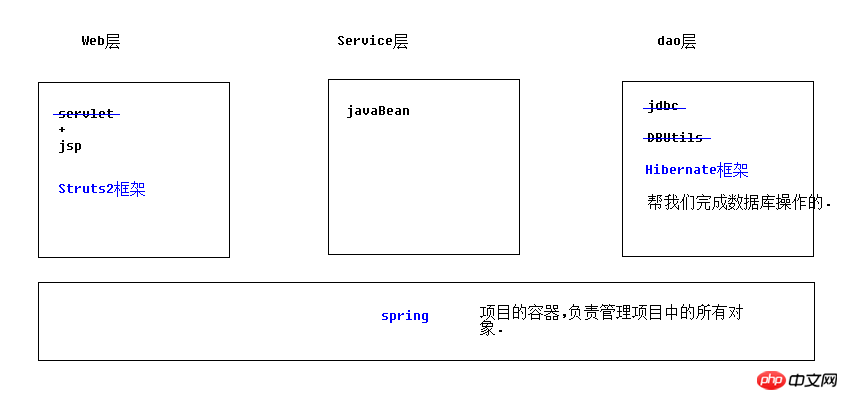 Hibernate의 장점:
Hibernate의 장점:
데이터베이스 운영 시 SQL 문을 작성할 필요가 없습니다.
hibernate는 ORM 프레임워크입니다.orm: 객체 관계 매핑
orm은 4개 레벨로 나뉩니다.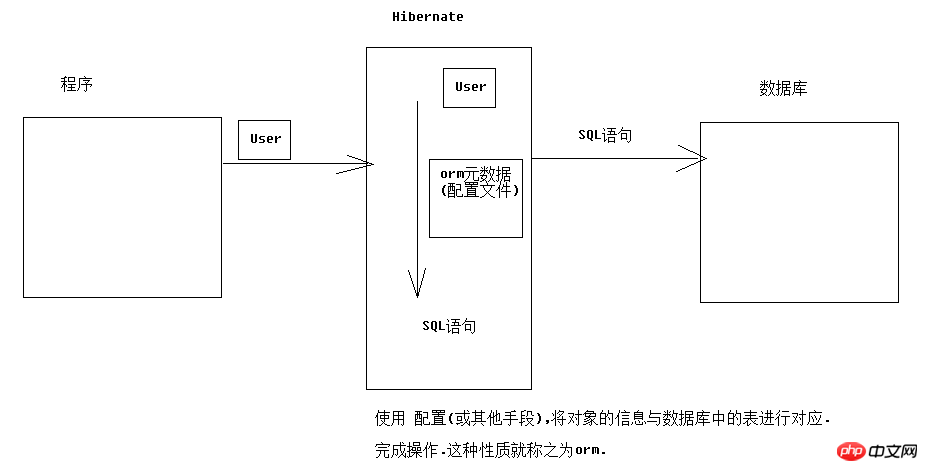 hibernate는 레벨 4에 속합니다: 완전 객체 지향 작업 데이터베이스
hibernate는 레벨 4에 속합니다: 완전 객체 지향 작업 데이터베이스
mybatis는 레벨에 속합니다. 2
dbutils는 레벨 1
에 속합니다. 2. 최대 절전 프레임워크 빌딩
1. 가이드 패키지
드라이버 패키지
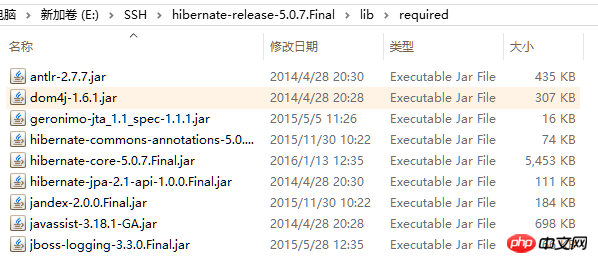
2 . 데이터베이스 생성, 테이블, 엔터티 준비 
 3. orm 메타데이터 작성(테이블이 포함된 객체 매핑 구성 파일)
3. orm 메타데이터 작성(테이블이 포함된 객체 매핑 구성 파일)
4. 기본 구성 파일(hibernate.cfg.xml)을 작성합니다
<?xml version="1.0" encoding="UTF-8"?><!DOCTYPE hibernate-configuration PUBLIC
"-//Hibernate/Hibernate Configuration DTD 3.0//EN"
"http://www.hibernate.org/dtd/hibernate-configuration-3.0.dtd"><hibernate-configuration><session-factory><!--
#hibernate.dialect org.hibernate.dialect.MySQLDialect
#hibernate.dialect org.hibernate.dialect.MySQLInnoDBDialect
#hibernate.dialect org.hibernate.dialect.MySQLMyISAMDialect
#hibernate.connection.driver_class com.mysql.jdbc.Driver
#hibernate.connection.url jdbc:mysql:///test
#hibernate.connection.username gavin
#hibernate.connection.password --> <!-- 数据库驱动 --><property name="hibernate.connection.driver_class">com.mysql.jdbc.Driver</property> <!-- 数据库url --><property name="hibernate.connection.url">jdbc:mysql:///hibernate_32</property> <!-- 数据库连接用户名 --><property name="hibernate.connection.username">root</property> <!-- 数据库连接密码 --><property name="hibernate.connection.password">1234</property><!-- 数据库方言
不同的数据库中,sql语法略有区别. 指定方言可以让hibernate框架在生成sql语句时.针对数据库的方言生成.
sql99标准: DDL 定义语言 库表的增删改查
DCL 控制语言 事务 权限
DML 操纵语言 增删改查
注意: MYSQL在选择方言时,请选择最短的方言. --><property name="hibernate.dialect">org.hibernate.dialect.MySQLDialect</property>
<!-- #hibernate.show_sql true
#hibernate.format_sql true--><!-- 将hibernate生成的sql语句打印到控制台 --><property name="hibernate.show_sql">true</property><!-- 将hibernate生成的sql语句格式化(语法缩进) --><property name="hibernate.format_sql">true</property><!--
## auto schema export 自动导出表结构. 自动建表
#hibernate.hbm2ddl.auto create 自动建表.每次框架运行都会创建新的表.以前表将会被覆盖,表数据会丢失.(开发环境中测试使用)
#hibernate.hbm2ddl.auto create-drop 自动建表.每次框架运行结束都会将所有表删除.(开发环境中测试使用)
#hibernate.hbm2ddl.auto update(推荐使用) 自动生成表.如果已经存在不会再生成.如果表有变动.自动更新表(不会删除任何数据).
#hibernate.hbm2ddl.auto validate 校验.不自动生成表.每次启动会校验数据库中表是否正确.校验失败. --><property name="hibernate.hbm2ddl.auto">update</property><!-- 引入orm元数据
路径书写: 填写src下的路径 --><mapping resource="cn/itheima/domain/Customer.hbm.xml" /></session-factory></hibernate-configuration>
//测试Hibernate框架public class Demo {
@Test//保存客户public void fun1(){
Configuration conf = new Configuration().configure();
SessionFactory sessionFactory = conf.buildSessionFactory();
Session session = sessionFactory.openSession();
Transaction tx = session.beginTransaction();//----------------------------------------------Customer c = new Customer();
c.setCust_name("google公司");
session.save(c);//执行保存 //---------------------------------------------- tx.commit();
session.close();
sessionFactory.close();
}
}
3. 구성 자세한 파일 설명
orm 메타데이터
<?xml version="1.0" encoding="UTF-8"?><!DOCTYPE hibernate-mapping PUBLIC
"-//Hibernate/Hibernate Mapping DTD 3.0//EN"
"http://www.hibernate.org/dtd/hibernate-mapping-3.0.dtd">
<!-- 配置表与实体对象的关系 -->
<!-- package属性:填写一个包名.在元素内部凡是需要书写完整类名的属性,可以直接写简答类名了. --><hibernate-mapping package="cn.itheima.domain" ><!--
class元素: 配置实体与表的对应关系的
name: 完整类名
table:数据库表名 --><class name="Customer" table="cst_customer" ><!-- id元素:配置主键映射的属性
name: 填写主键对应属性名
column(可选): 填写表中的主键列名.默认值:列名会默认使用属性名
type(可选):填写列(属性)的类型.hibernate会自动检测实体的属性类型.
每个类型有三种填法: java类型|hibernate类型|数据库类型
not-null(可选):配置该属性(列)是否不能为空. 默认值:false
length(可选):配置数据库中列的长度. 默认值:使用数据库类型的最大长度 --><id name="cust_id" ><!-- generator:主键生成策略(明天讲) --><generator class="native"></generator></id><!-- property元素:除id之外的普通属性映射
name: 填写属性名
column(可选): 填写列名
type(可选):填写列(属性)的类型.hibernate会自动检测实体的属性类型.
每个类型有三种填法: java类型|hibernate类型|数据库类型
not-null(可选):配置该属性(列)是否不能为空. 默认值:false
length(可选):配置数据库中列的长度. 默认值:使用数据库类型的最大长度 --><property name="cust_name" column="cust_name" ><!-- <column name="cust_name" sql-type="varchar" ></column> --></property><property name="cust_source" column="cust_source" ></property><property name="cust_industry" column="cust_industry" ></property><property name="cust_level" column="cust_level" ></property><property name="cust_linkman" column="cust_linkman" ></property><property name="cust_phone" column="cust_phone" ></property><property name="cust_mobile" column="cust_mobile" ></property></class></hibernate-mapping>
필수 속성 구성(5)
<!-- 数据库驱动 --><property name="hibernate.connection.driver_class">com.mysql.jdbc.Driver</property> <!-- 数据库url --><property name="hibernate.connection.url">jdbc:mysql:///hibernate_32</property> <!-- 数据库连接用户名 --><property name="hibernate.connection.username">root</property> <!-- 数据库连接密码 --><property name="hibernate.connection.password">1234</property><!-- 数据库方言
不同的数据库中,sql语法略有区别. 指定方言可以让hibernate框架在生成sql语句时.针对数据库的方言生成.
sql99标准: DDL 定义语言 库表的增删改查
DCL 控制语言 事务 权限
DML 操纵语言 增删改查
注意: MYSQL在选择方言时,请选择最短的方言. --><property name="hibernate.dialect">org.hibernate.dialect.MySQLDialect</property> 선택 속성 구성(3)
<!-- #hibernate.show_sql true
#hibernate.format_sql true--><!-- 将hibernate生成的sql语句打印到控制台 --><property name="hibernate.show_sql">true</property><!-- 将hibernate生成的sql语句格式化(语法缩进) --><property name="hibernate.format_sql">true</property><!--
## auto schema export 自动导出表结构. 自动建表
#hibernate.hbm2ddl.auto create 自动建表.每次框架运行都会创建新的表.以前表将会被覆盖,表数据会丢失.(开发环境中测试使用)
#hibernate.hbm2ddl.auto create-drop 自动建表.每次框架运行结束都会将所有表删除.(开发环境中测试使用)
#hibernate.hbm2ddl.auto update(推荐使用) 自动生成表.如果已经存在不会再生成.如果表有变动.自动更新表(不会删除任何数据).
#hibernate.hbm2ddl.auto validate 校验.不自动生成表.每次启动会校验数据库中表是否正确.校验失败. --><property name="hibernate.hbm2ddl.auto">update</property>
<!-- 引入orm元数据
路径书写: 填写src下的路径 --><mapping resource="cn/itheima/domain/Customer.hbm.xml" />
IV. hibernate API 상세 설명
Learning Configuration 객체
//学习Configuration对象// Configuration功能: 配置加载类.用于加载主配置,orm元数据加载public class Demo {
@Testpublic void fun1(){//1 创建,调用空参构造Configuration conf = new Configuration();//2 读取指定主配置文件 => 空参加载方法,加载src下的hibernate.cfg.xml文件 conf.configure();//3 读取指定orm元数据(扩展),如果主配置中已经引入映射配置.不需要手动加载//conf.addResource(resourceName);//conf.addClass(persistentClass); //4 根据配置信息,创建 SessionFactory对象SessionFactory sf = conf.buildSessionFactory();
}
}
Learning Se ssionFactory 객체
//学习SessionFactory对象// SessionFactory功能: 用于创建操作数据库核心对象session对象的工厂.// 简单说功能就一个---创建session对象//注意:1.sessionfactory 负责保存和使用所有配置信息.消耗内存资源非常大.// 2.sessionFactory属于线程安全的对象设计.//结论: 保证在web项目中,只创建一个sessionFactory.public class Demo2 {
@Testpublic void fun1(){//1 创建,调用空参构造Configuration conf = new Configuration();//2 读取指定主配置文件 => 空参加载方法,加载src下的hibernate.cfg.xml文件 conf.configure();//3 读取指定orm元数据(扩展),如果主配置中已经引入映射配置.不需要手动加载//conf.addResource(resourceName);//conf.addClass(persistentClass); //4 根据配置信息,创建 SessionFactory对象SessionFactory sf = conf.buildSessionFactory();//--------------------------------------------------//5 获得session//打开一个新的session对象 sf.openSession();//获得一个与线程绑定的session对象(明天讲解) sf.getCurrentSession();
}
}학습 세션 개체 :추가, 삭제, 확인 및 수정
//学习Session对象//session对象功能: 表达hibernate框架与数据库之间的连接(会话).session类似于// JDBC年代的connection对象. 还可以完成对数据库中数据的增删改查操作.// session是hibernate操作数据库的核心对象public class Demo3 {
@Test//事务操作public void fun1(){//1 创建,调用空参构造Configuration conf = new Configuration().configure();//2 根据配置信息,创建 SessionFactory对象SessionFactory sf = conf.buildSessionFactory();//3 获得sessionSession session = sf.openSession();//4 session获得操作事务的Transaction对象//获得操作事务的tx对象//Transaction tx = session.getTransaction();//开启事务并获得操作事务的tx对象(建议使用)Transaction tx2 = session.beginTransaction();//----------------------------------------------
//----------------------------------------------tx2.commit();//提交事务tx2.rollback();//回滚事务session.close();//释放资源sf.close();//释放资源 }
@Test//session的新增public void fun2(){//1 创建,调用空参构造Configuration conf = new Configuration().configure();//2 根据配置信息,创建 SessionFactory对象SessionFactory sf = conf.buildSessionFactory();//3 获得sessionSession session = sf.openSession();//4 session获得操作事务的Transaction对象//获得操作事务的tx对象//Transaction tx = session.getTransaction();//开启事务并获得操作事务的tx对象(建议使用)Transaction tx2 = session.beginTransaction();//----------------------------------------------Customer c = new Customer();
c.setCust_name("传智播客");
session.save(c);//----------------------------------------------tx2.commit();//提交事务session.close();//释放资源sf.close();//释放资源 }
@Test//session的查询//查询id为1的customer对象public void fun3(){//1 创建,调用空参构造Configuration conf = new Configuration().configure();//2 根据配置信息,创建 SessionFactory对象SessionFactory sf = conf.buildSessionFactory();//3 获得sessionSession session = sf.openSession();//4 session获得操作事务的Transaction对象//获得操作事务的tx对象//Transaction tx = session.getTransaction();//开启事务并获得操作事务的tx对象(建议使用)Transaction tx2 = session.beginTransaction();//----------------------------------------------
Customer customer = session.get(Customer.class, 1l);
System.out.println(customer);//----------------------------------------------tx2.commit();//提交事务session.close();//释放资源sf.close();//释放资源 }
@Test//session的修改//修改id为1的customer对象的name属性为黑马程序员public void fun4(){//1 创建,调用空参构造Configuration conf = new Configuration().configure();//2 根据配置信息,创建 SessionFactory对象SessionFactory sf = conf.buildSessionFactory();//3 获得sessionSession session = sf.openSession();//4 session获得操作事务的Transaction对象//获得操作事务的tx对象//Transaction tx = session.getTransaction();//开启事务并获得操作事务的tx对象(建议使用)Transaction tx2 = session.beginTransaction();//----------------------------------------------//1 获得要修改的对象Customer c = session.get(Customer.class, 1l);//2 修改c.setCust_name("黑马程序员");//3 执行update session.update(c);//----------------------------------------------tx2.commit();//提交事务session.close();//释放资源sf.close();//释放资源 }
@Test//session的删除//删除id为1的customer对象public void fun5(){//1 创建,调用空参构造Configuration conf = new Configuration().configure();//2 根据配置信息,创建 SessionFactory对象SessionFactory sf = conf.buildSessionFactory();//3 获得sessionSession session = sf.openSession();//4 session获得操作事务的Transaction对象//获得操作事务的tx对象Transaction tx = session.getTransaction();
tx.begin();//开启事务并获得操作事务的tx对象(建议使用)Transaction tx2 = session.beginTransaction();//----------------------------------------------//1 获得要修改的对象Customer c = session.get(Customer.class, 1l);//2 调用delete删除对象 session.delete(c);//----------------------------------------------tx2.commit();//提交事务session.close();//释放资源sf.close();//释放资源 }
}
이전 단계는 이전 참고 사항을 참조하세요. 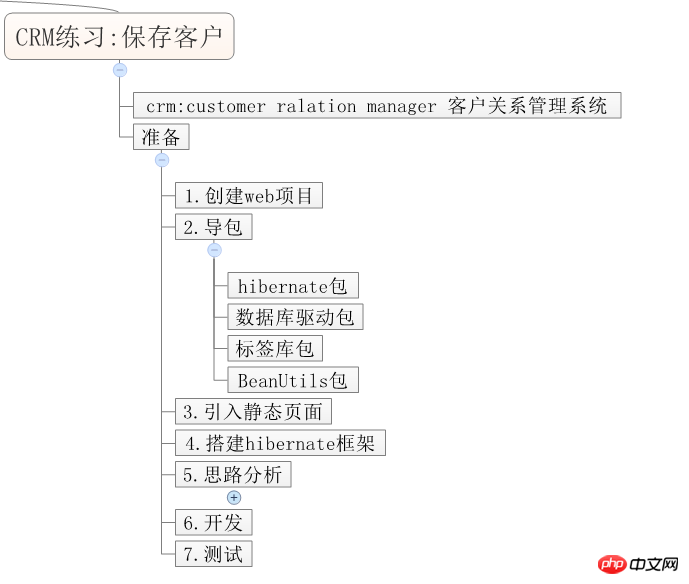 5. 아이디어 분석
5. 아이디어 분석
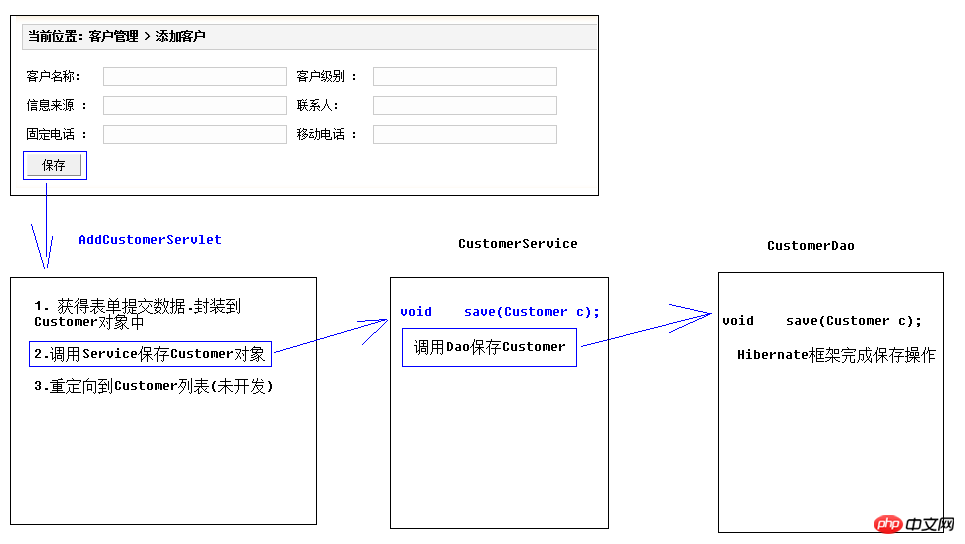
public class HibernateUtils {private static SessionFactory sf; static{//1 创建,调用空参构造Configuration conf = new Configuration().configure();//2 根据配置信息,创建 SessionFactory对象 sf = conf.buildSessionFactory();
} //获得session => 获得全新sessionpublic static Session openSession(){//3 获得sessionSession session = sf.openSession(); return session;
}//获得session => 获得与线程绑定的sessionpublic static Session getCurrentSession(){//3 获得sessionSession session = sf.getCurrentSession(); return session;
}public static void main(String[] args) {
System.out.println(HibernateUtils.openSession());
}
}
작업의 핵심 코드:
/**
* Servlet implementation class AddCustomerServlet */public class AddCustomerServlet extends HttpServlet {private static final long serialVersionUID = 1L; private CustomerService customerService = new CustomerServiceImpl();protected void doGet(HttpServletRequest request, HttpServletResponse response) throws ServletException, IOException {//1 获得参数并封装到Customer对象Customer c = new Customer();try {
BeanUtils.populate(c, request.getParameterMap());
} catch (IllegalAccessException e) {
e.printStackTrace();
} catch (InvocationTargetException e) {
e.printStackTrace();
}//2 调用Service保存客户 customerService.save(c);//3 重定向到客户列表response.sendRedirect(request.getContextPath()+"/ListCustomerServlet");
}protected void doPost(HttpServletRequest request, HttpServletResponse response) throws ServletException, IOException {
doGet(request, response);
}
}
서비스 계층:
public class CustomerServiceImpl implements CustomerService {private CustomerDao customerDao = new CustomerDaoImpl();public void save(Customer c) {//调用Dao保存客户 customerDao .save(c);
}
}dao 계층:
public class CustomerDaoImpl implements CustomerDao {public void save(Customer c) {//1 获得sessionSession session = HibernateUtils.openSession();//2 打开事务Transaction tx = session.beginTransaction();//3 执行保存 session.save(c);//4 提交事务 tx.commit();//5 关闭资源 session.close();
}
}위 내용은 hibernate01: 소개, 구성, 구성 파일 세부사항, API 세부사항 및 CRM 연습: 고객 절약의 상세 내용입니다. 자세한 내용은 PHP 중국어 웹사이트의 기타 관련 기사를 참조하세요!

